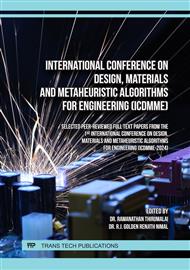[1]
Mark Billinghurst, Adrian Clark, and Gun Lee. 2015. A survey of augmented reality. Foundations and Trends in Human-Computer Interaction 8, 2-3 (2015), 73–272.
DOI: 10.1561/1100000049
Google Scholar
[2]
Z. Li, C. Yang, and E. Burdet, "An overview of biomedical robotics and bio-mechatronics systems and applications," IEEE Trans. Syst., Man, Cybern., Syst., vol. 46, no. 7, p.869–874, Jul. 2016.
DOI: 10.1109/tsmc.2016.2571786
Google Scholar
[3]
O.M. Omisore et al., "Non-iterative geometric approach for inverse kinematics of redundant lead-module in a radiosurgical snake-like robot," BioMed. Eng. Online, vol. 16, no. 1, p.1–21, Dec. 2017.
DOI: 10.1186/s12938-017-0383-2
Google Scholar
[4]
L. Le, A. Patterson, and M. White, "Supervised autoencoders: Improving generalization performance with unsupervised regularizers," in Proc. Adv. Neural Inf. Process. Syst., 2018, p.107–117.
Google Scholar
[5]
B. Sadrfaridpour and Y. Wang, "Collaborative assembly in hybrid manufacturing cells: An integrated framework for human–robot interaction," IEEE Trans. Automat. Sci. Eng., vol. 15, no. 3, p.1178–1192, Jul. 2018.
DOI: 10.1109/tase.2017.2748386
Google Scholar
[6]
R. Chalapathy and S. Chawla, "Deep learning for anomaly detection: A survey," 2019, arXiv:1901.03407.
Google Scholar
[7]
T. Ji, S. T. Vuppala, G. Chowdhary, and K. Driggs-Campbell, "Multimodal anomaly detection for unstructured and uncertain environments," in Proc. Conf. Robot Learn., 2020, p.1443–1455.
Google Scholar
[8]
Z. Zhang, E. Kayacan, B. Thompson, and G. Chowdhary, "High precision control and deep learning-based corn stand counting algorithms for agricultural robot," Auton. Robots, vol. 44, no. 7, p.1289–1302, 2020.
DOI: 10.1007/s10514-020-09915-y
Google Scholar
[9]
"Coronavirus Graphs: Worldwide Cases and Deaths - Worldometer." [Online].Available: https://www.worldometers.info/coronavirus/worldwide-graphs/#totalcases. [Accessed: 10-Nov-2020].
Google Scholar
[10]
A. Casalino, A. M. Zanchettin, L. Piroddi, and P. Rocco, "Optimal scheduling of human–robot collaborative assembly operations with time Petri nets," IEEE Trans. Automat. Sci. Eng., vol. 18, no. 1, p.70–84, Jan. 2021.
DOI: 10.1109/tase.2019.2932150
Google Scholar
[11]
Optimal planning and allocation of Plug-in Hybrid Electric Vehicles charging stations using a novel hybrid optimization technique, Ayyappan Subramaniam, LRS Ravi Singh - Plos one, 2023.
DOI: 10.1371/journal.pone.0284421
Google Scholar


